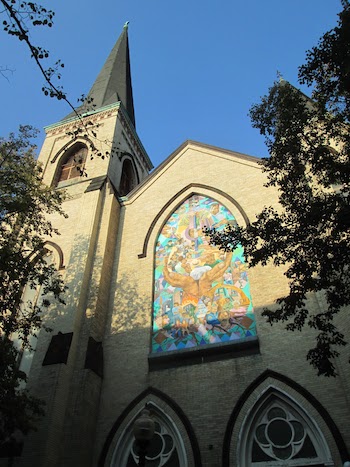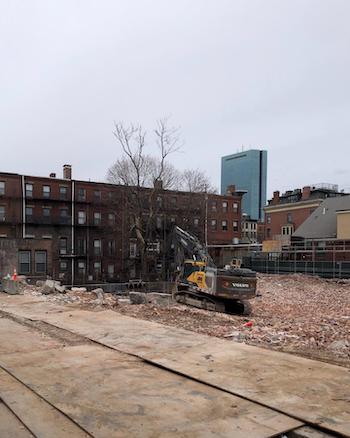Visual Arts Commentary: Preservation, Two Cases of To Be or Not to Be
By Mark Favermann
Today’s increasingly heated argument about architectural preservation revolves around discerning which pieces of the past are worth saving, which buildings are valuable to our present and future.

Former Villa Victoria Art Center, 85 Newton Street, Boston’s South End, Photo Source: Exploring Massachusetts
Recently, two architectural developments were demolished, and the destruction sparked consternation if not controversy. The fate of these different buildings raises what has become an increasingly heated conversation, often devolving into angry debate, about which structures should be saved and which removed. In many ways, the architectural preservation process has turned into a dramatic standoff that pits adversaries with clashing perspectives against one another in an argument about what best benefits society: it is progressive politics versus moral authority versus money-making versus nostalgia.
One of the erased buildings was an 1899 Boston church and parish house located at 85 West Newton Street in Boston’s South End. It was originally designed by the Reverend Thomas W. Silloway in an aesthetically appealing German Gothic style. For a number of decades it served as a Zion Evangelical Lutheran Church. In 1980, the nonprofit group Inquilinos Boricuas en Acción (IBA) repurposed the structure into a cultural center, preschool, and performing arts center that supported Boston’s Latino community.
The Villa Victoria Arts Center was housed in a buff-colored brick building that included a square tower, angle buttresses, and a shingled spire. Tracery — stone bars, ribs, or other supports between sections of glass that have decorative as well as utilitarian purposes — punctuated the facade’s windows. These decorative devices were designed to give the impression of frames or outlines. The church structure was attached to a parish house that featured similar details and materials.
Any changes to the building needed to be reviewed and approved by the South End Landmark District Commission. Villa Victoria was also on both the Massachusetts and national registers of historic places. So, a series of bureaucratic meetings with a number of agencies, both public and private, needed to take place before final determination of the outcome.
The other building now gone was an early ’70s Brutalist building in North Carolina. The pharmaceutical company Burroughs Wellcome (later bought by GlaxoSmithKline) hired architect Paul Rudolph to design the building when it decided to move its headquarters from suburban New York to the Raleigh, NC, research triangle area in 1969. Of note: the HIV and AIDS drug AZT was created there. Rudolph was known for favoring architecture whose surfaces were raw-looking, angular, and very hard. The result was spare, sometimes hulking, often precast concrete structures. After its often controversial proliferation during the ’60s and early ’70s, Brutalism fell out of favor by the ’80s. Along with a plethora of maintenance issues, the buildings didn’t age well materially or visually.
In recent years, there has been a revival of interest in Brutalism. Fans of the approach, mostly younger architects, say they appreciate “the honesty and integrity” of this “sculptural” form. Style triumphs over humane substance in this argument. In terms of this and other Brutalist structures, few consider the style to be innovative and futuristic. For example, a majority of people in the Raleigh area viewed the pharmaceutical building as an ugly eyesore.

After the demolition of Villa Victoria. Photo: Matthew Dickey.
In both cases, property owners insisted that restoration of the structures was too costly. Demolition of the existing buildings followed by new construction made the most sense financially.
The process of preservation varies greatly in different parts of the United States.
In Massachusetts, a series of bureaucratic reviews, including pertinent agencies of the City of Boston, the Commonwealth of Massachusetts, and even the South End neighborhood oversight committees, need to be scheduled with the owners/developers. Other less formal meetings were held with structural engineers, who reviewed recommendations that aimed to stabilize the infrastructure as well as incorporate needed repairs into the building. Owners felt that the considerable funding needed for restoration made the project a nonstarter.
The bottom line is the ultimate test for a developer, but advocacy groups have their say in the decision to save or demolish. In Boston, the Boston Preservation Alliance is dedicated to strategically considering the preservation, restoration, or demolition of the city’s historical structures. This nonprofit involved itself at key points in the review and negotiation process regarding the Villa Victoria
A parallel but much more narrowly focused organization, the Paul Rudolph Foundation, acted similarly to advocate for the survival of Rudolph’s Big Pharma structure in North Carolina. This group’s mission is to facilitate the preservation and maintenance of the structures [that still stand] designed by Paul Rudolph. The organization is dedicated to education, advocacy, preservation, and providing technical services. They did not succeed in their goal to preserve this building.
Two cadres of advocacy are squaring off in the contemporary preservation debate. The Classicism group feels that, after the 1920s, little of architectural significance was built. On the other side, Modernists insist that the rigid elitism of what Classicism considers to be traditional is anathema to meaningful human progress. They point out that these edifices represent a time of exclusion, an era when women, subjugated people, the poor, and slaves were excluded. According to this view, Classicism represents a time when Western ideals inevitably dominated weaker peoples and their cultures. Given our multicultural future, Classicism is well past its shelf-life.
Part of the Modernist attack believes that there is a tendency to romanticize historic architecture, based on surviving structures. Most of the housing in ancient Greece didn’t mirror the Parthenon; medieval houses had little in common with Gothic cathedrals or universities, etc. Some ancient architecture — admittedly distinctive and beautiful — survived. Other buildings in the past were allowed to fade away.

Burroughs-Wellcome Building by Paul Rudolph, 1972. Photo: Paul Rudolph Heritage Foundation.
Two articulate opponents, Leon Krier (Prince Charles’s architectural advisor) and Dr. Nir Buras, architect, urbanist, and author of The Art of Classic Planning, insist that a Classical approach to building offers the best way to balance town and country because it poses an alternative to what they see as dystopian Modernism. To them, utilizing the elements from old, traditional, and classic built environments represents a way to enhance our present and future. Being stylistically contemporary is not enough; they argue that what’s historically memorable reflects standards of excellence whose values are rooted in our humanity.
Preservation is the process of keeping significant and culturally relevant physical structures alive, intact, or free from damage or decay. Complicating this is that the building developer/owner is forced to think strategically about a project — to juggle economics, history, and issues of cultural significance. Today’s increasingly heated argument about architectural preservation revolves around discerning which pieces of the past are worth saving, which buildings are valuable to our present and future.
An urban designer and public artist, Mark Favermann has been deeply involved in branding, enhancing, and making more accessible parts of cities, sports venues, and key institutions. Also an award-winning public artist, he creates functional public art as civic design. The designer of the renovated Coolidge Corner Theatre, he is design consultant to the Massachusetts Downtown Initiative Program and, since 2002, he has been a design consultant to the Red Sox. Writing about urbanism, architecture, design and fine arts, Mark is Associate Editor of Arts Fuse.

[…] Read more […]
This a concise presentation of a complex issue. There is an impulse to preserve the past and counter to that the cost and pragmatism, Indeed brutalism has not aged well. Poured concrete was initially thought of as cheap and durable. But decades of exposure to the elements reveals deterioration. In the case of an iconic structure like the Guggenheim Museum the costly renovation project was justified. These difficult decisions are made on a case by case basis. Mark has laid out the pros and cons.
Preservation can be a controversial issue. Inevitable conflicts are baked into it: private vs. public benefit; valuing heritage vs. novelty; and – deepest of all – appreciating the reality and power of beauty vs. turning everything into a commodity. We – the Paul Rudolph Heritage Foundation [the article got our name wrong] are actively seeking to preserve Paul Rudolph’s work and mindful of the practical aspects of any preservation fight.
The author makes clear in his article why it’s harder to save one building over the other: he presents an “aesthetically appealing” German Gothic Church over a “hulking” building with maintenance issues that “didn’t age well materially or visually” which is the author claims (without evidence) that “a majority of the Raleigh area viewed … as an ugly eyesore.” I wonder if he asked any of the 930 members of the Burroughs Wellcome Alumni group on Facebook who actively supported saving the building what they thought of it when they worked in it.
Several key points need to be clarified in order to get a realistic picture of the case of the Burroughs Wellcome building:
Burroughs Wellcome was not considered under threat – by us or any local and national preservation groups – and that’s for several reasons:
• A HABS (Historic American Buildings Survey) report was written the building, establishing its national importance for architectural, cultural and historical reasons.
• United Therapeutics (the new owner) had, when they acquired the building, promised to preserve it after selectively demolishing a part of it in 2012.
• By the time we heard about demolition plans, a permit had already been issued – and its issuance was objected by several local and national preservation groups.
We’re currently working with the other organization mentioned in the article – the Boston Preservation Alliance – on saving another significant building by Paul Rudolph: the Boston Government Service Center. There, through carefully examining and challenging the premises of the forces proposing demolition, it appears that plans for the building have changed for the better, and preservation will now to be a key factor in its future.
Th Boston example shows that—if we get early knowledge of a threat to a great building—then positive changes to its fate can be made. That wasn’t the case with Burroughs Wellcome, a building whose loss is mourned by people from around the world – and not just by younger architects.
Well, supporters of brutalism are like Trump supporters – they live in an alternate reality, and you can’t argue with them. Just look at that Paul Rudolph atrocity – I’m surprised it didn’t make it into A Clockwork Orange. As for Villa Victoria – what a tragedy Not a great building, just a charming and humane one that served as a kind of button on the urban fabric of the South End. The odds of a superior replacement for it are effectively zero.
Preservation is indeed a complex issue. I lived in the South End for 30 years and am sorry to learn about the loss of Villa Victoria’s edifice. I also think the brutalist building in North Carolina is stunning. However, it does sound as though both projects went through extensive community reviews. Your article is very well written.